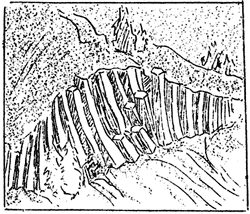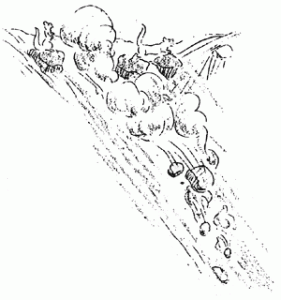Columnar Structure in Our Lavas
By E. L. Clark, Ranger Naturalist
Many of our visitors have wondered if the elongated columns of rock that are observed in various parts of our Park are petrified logs, i.e. logs that were neatly arranged in piles and bundles, then turned to rock by some unknown and uncanny process. It is found in our lava flows and dikes, and is due to the regular development of prismatic joints that break up the rock mass into parallel columns, the sides of which are characteristically five or six in number. This rock phenomenon is known as columnar structure. While most of the columns will portray a rough and irregular hexagonal outline, many of them will have the sixth side so depressed and small that it is entirely eliminated.
This structure is variously portrayed in our Park. It may be observed at the following localities within the Rim Area: (1) the upper exposed portions of the andesite dike about two hundred yards west of the foot of the Lake Trail; (2) in a small area some forty feet above the Lake and fifty yards west of the dike just mentioned; (3) the Devil’s Woodpile some seven hundred yards west of the foot of the Lake Trail (this feature is observed on the lake excursions under the guidance of some member of our Naturalist Staff); (4) parts of the dike known as the Devils’ Backbone; (5) near the base of the great dacite flow that forms Llao Rock; (6) the constriction at the base of the bowl portion of the Wineglass; and (7) in the lava flow on the inside of the Rim below Kerr Notch. Near the crest of the steep portion of the grade over Vidae Ridge, and facing Sun Creek Valley some six-tenths of a mile southwest of the Sun Creek crossing another exposure of columnar lava may be observed. Here the lava has been poured onto a trifaceous agglomerate (a chaotic assemblage of coarse volcanic ashes and cinders). The attitude of the lava readily suggests its direct relations to the former mountain.
Random Observations
By E. L. Clark, Ranger Naturalist
A Western Belted Kingfisher was observed twice on Wizard Island, July 16, by the party conducted by Dr. May, State Ornithologist for Massachusetts. The first time it rose from the shore near the boat-landing. Later it was seen streaking through the trees a few yards from the shore-line.
A California gull was also seen wheeling over the lake. Ranger-Naturalist Clark reported that from the Sinnott Memorial. Two were seen.
The Bald Eagle that has habituated Eagle Rock was perched for an indefinitely long time on a hemlock in his usual haunt.
The Receding Rim of Crater Lake
By D. L. Evans, Ranger Naturalist
The rim of the caldera has been worked upon, worn back and eroded by many of the tools of nature. Melting snows in the early summer carry into the lake a vast amount of material. Sliding snow undoubtedly has its effect in the winter time. The prying force of ice – the sand blast of wind – all of these things perform a never ending task the result of which (a few geologic hours away) wear down the Rim. Of course, we will never live to see that time, or will or progeny. But Nature, may I put in a word for two great workhorses: the Crater Lake Ground Squirrel, and his cousin the chipmunk.
The observant person standing on the Rim will note that fifteen minutes is a long period between rolling boulders. He will also note that boulder slides do not start by chance – that behind it all is some perniceous rodent.
Mr. Ground Squirrel’s technique is perfect. A small rolling pebble and he scores a ten strike against one a little larger. Down the wall the material goes until a landslide is the result of the first pebble.
Some ambitious student might calculate the tonnage and volume of rock entering the lake daily in this fashion and calculate how many millions of years it will take the chipmunk clan to destroy the West Rim.



